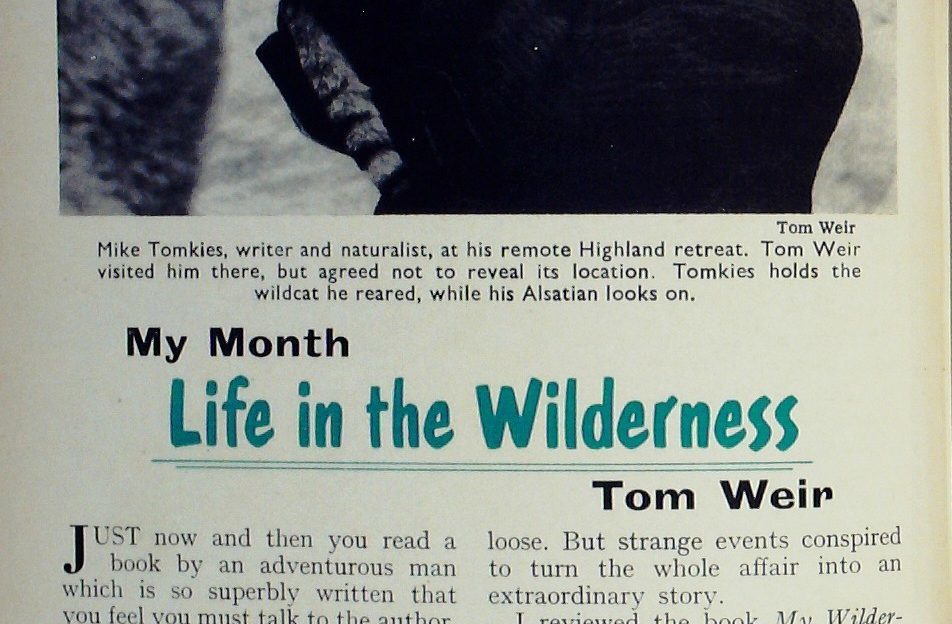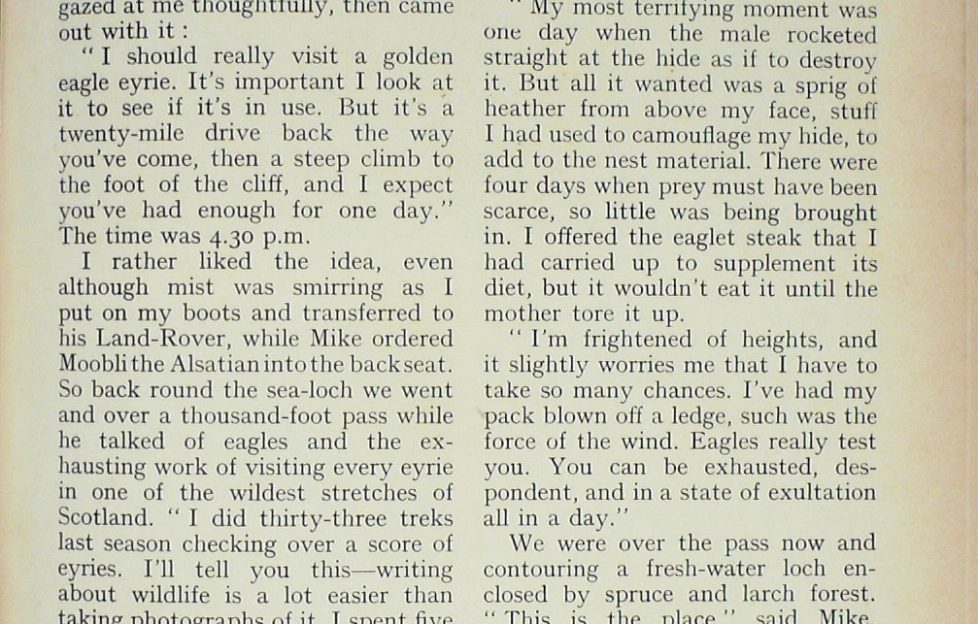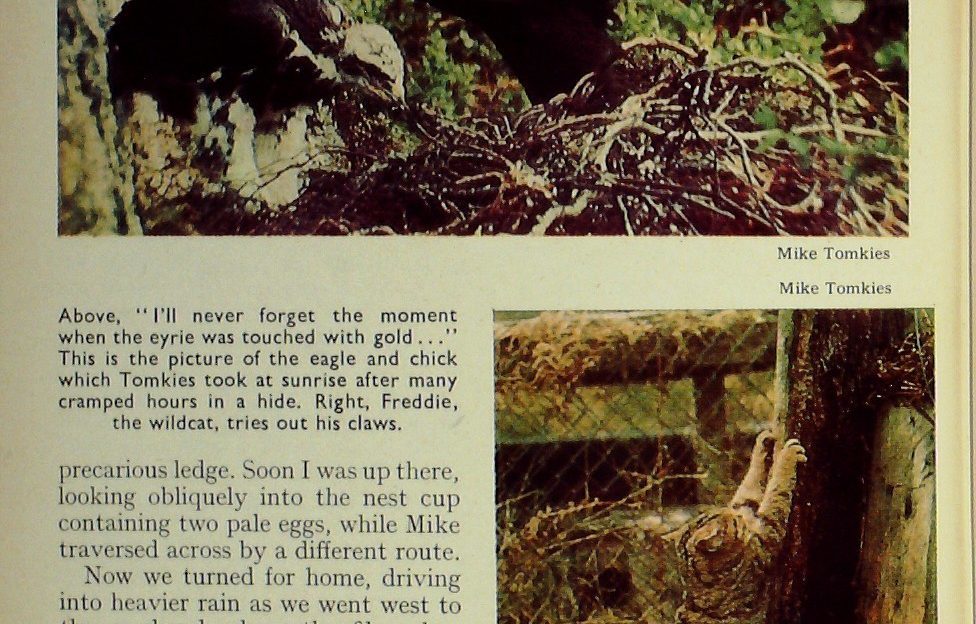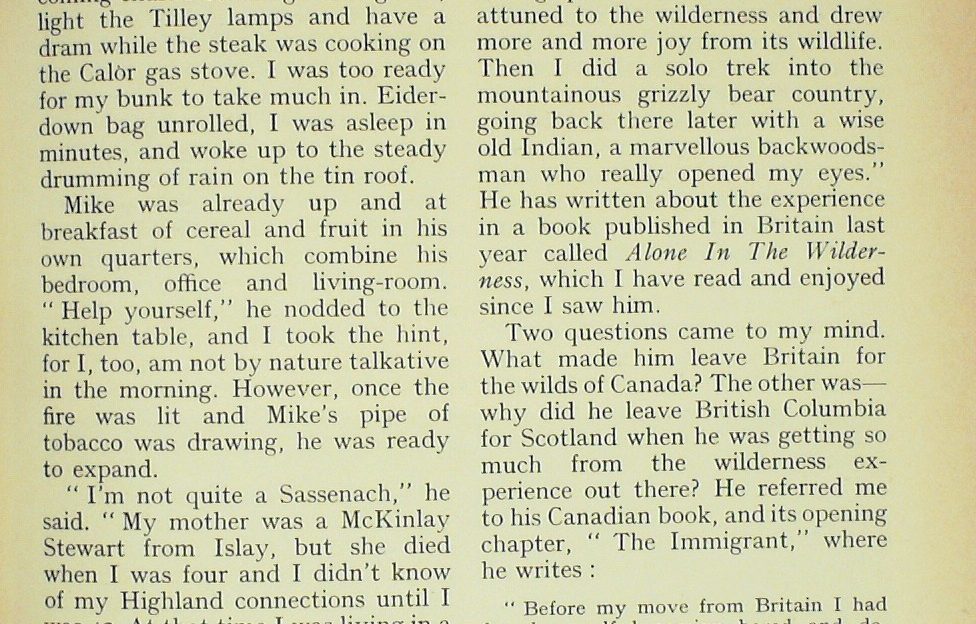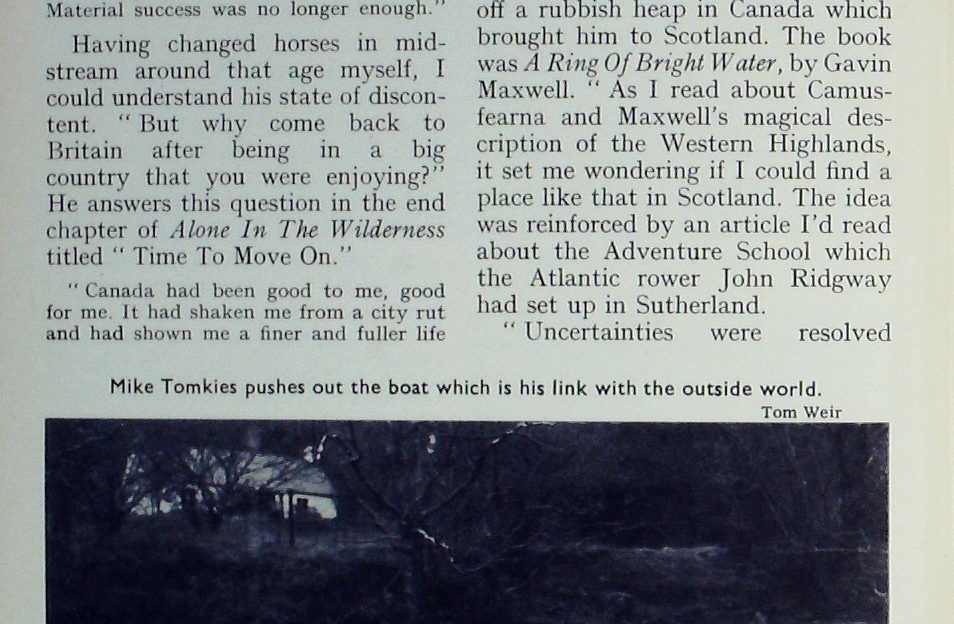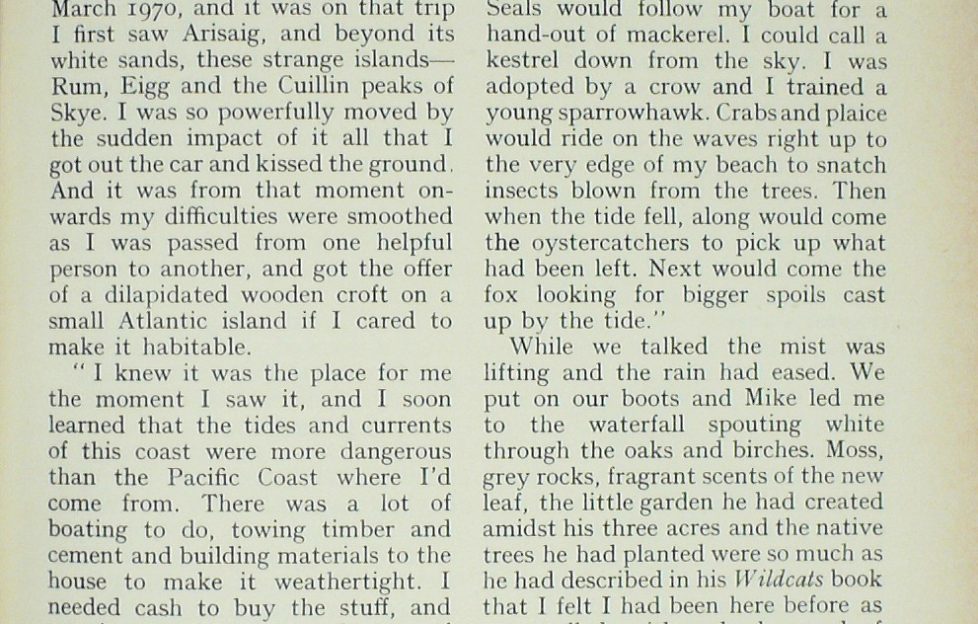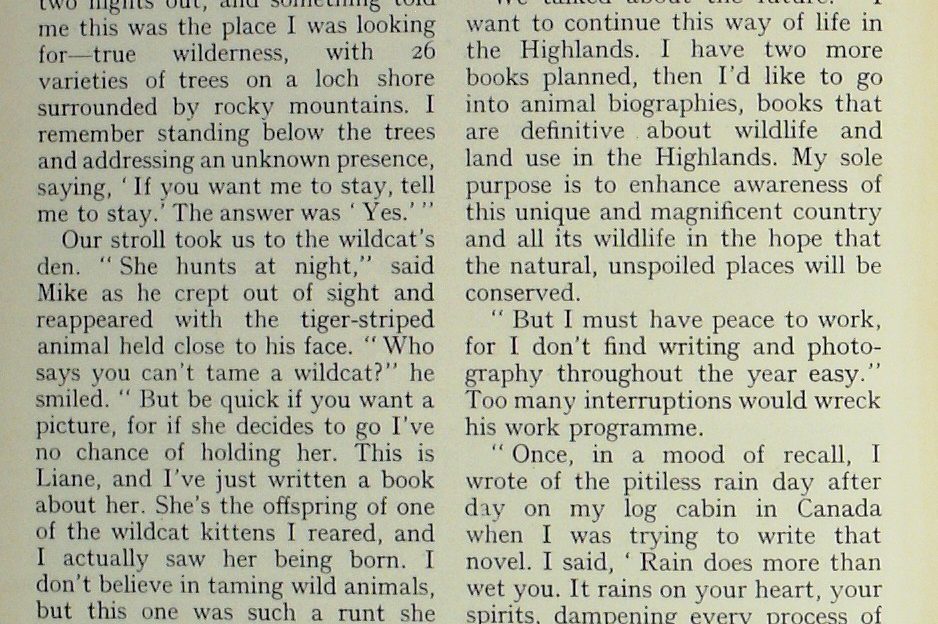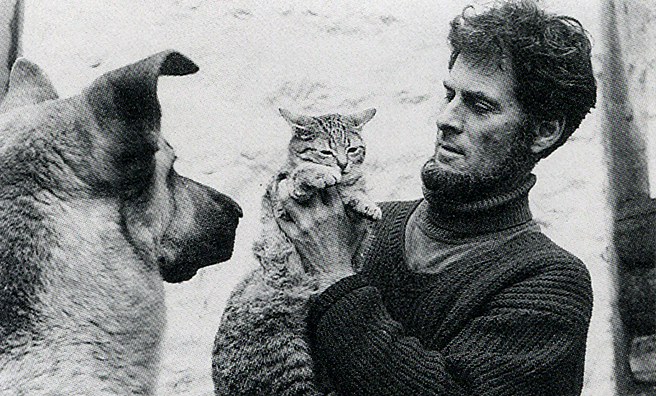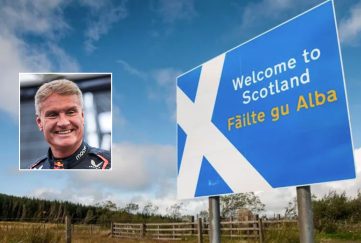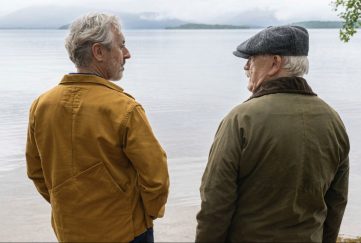Tom Weir | Life in the Wilderness
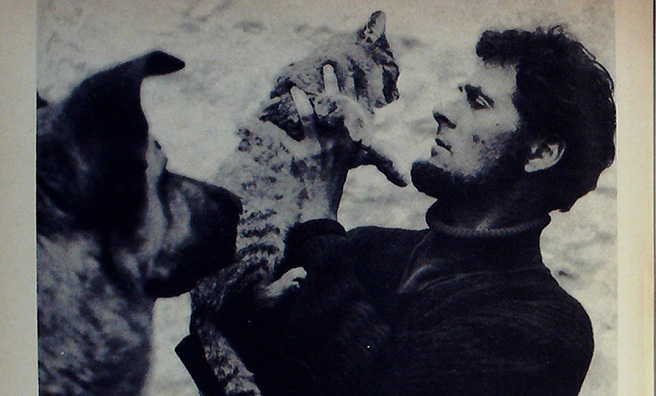
Author and naturalist Mike Tomkies took our Tom eyrie-checking and to experience the life in the wilds…
Just now and then you read a book by an adventurous man which is so superbly written that you feel you must talk to the author. Not since Gavin Maxwell’s Ring of Bright Water, with its incredibly rich vision of the Western Highlands, had I been so powerfully moved.
What otters were to Maxwell—a source of inspiration giving meaning to his life when he most needed it — so, I felt, were wildcats to Mike Tomkies. Where Tomkies differed from Maxwell was that he had no wish to make pets of his wildcats. Having rescued them when they were abandoned by the mother, he felt it his duty to rear them and let them loose. But strange events conspired to turn the whole affair into an extraordinary story.
I reviewed the book My Wilderness Wildcats enthusiastically in the January 1978 issue of this magazine, but I had no clue as to where the wilderness was, for no place-names were given. The author obviously wanted to keep the location secret and, respecting his privacy, I didn’t even consider trying to find out.
A Blind Date
Then the unexpected happened: he wrote to thank me for the review. I replied suggesting we meet and so we did, at the remote post-office where he collects his mail once a week in summer – it was a blind date. What would he be like?
I had to wait longer than I expected before a tall and lithe figure, wearing a camouflage jacket, held out his hand and said, “Mike Tomkies. Sorry I’m late.”
His manner was matter of fact, not effusive. The voice was English. The determined face had a fringe of whiskers and a chin beard, with a few grey hairs among the dark. I thought we would be off immediately to the remote road-end where he keeps his boat. Instead, he gazed at me thoughtfully, then came out with it:
“I should really visit a golden eagle eyrie. It’s important I look at it to see if it’s in use. But it’s a twenty-mile drive back the way you’ve come, then a steep climb to the foot of the cliff, and I expect you’ve had enough for one day.” The time was 4.30 p.m.
I rather liked the idea, even although mist was smirring as I put on my boots and transferred to his Land-Rover, while Mike ordered Moobli the Alsatian into the backseat. So back round the sea-loch we went and over a thousand-foot pass while he talked of eagles and the exhausting work of visiting every eyrie in one of the wildest stretches of Scotland.
“I did thirty-three treks last season checking over a score of eyries. I’ll tell you this—writing about wildlife is a lot easier than taking photographs of it. I spent five nights out in a small hide at one eyrie. The longest continuous spell was thirty-one hours. I felt terrible at the end of it. Even with a sleeping-bag it was freezing cold and uncomfortable. But I found out what I wanted to know—that the eagle hunts and brings in prey at night. The problem of flying into a cliff ledge under an overhang with trees and landing on it must be really difficult. I also discovered that it sleeps with its head under its wing like a duck, brooding its chick all the while.
“Eagles really test you…”
“The big thrill was to be awake while the eagle was asleep, then see it push its head out, open its eyes, close them again and nuzzle down for another forty winks. I was waiting for the sunrise, and I’ll never forget the moment when the eyrie was touched with gold and I pressed the camera shutter to get my best picture of an eagle with its chick.
“My most terrifying moment was one day when the male rocketed straight at the hide as if to destroy it. But all it wanted was a sprig of heather from above my face, stuff I had used to camouflage my hide, to add to the nest material. There were four days when prey must have been scarce, so little was being brought in. I offered the eaglet steak that I had carried up to supplement its diet, but it wouldn’t eat it until the mother tore it up.
“I’m frightened of heights, and it slightly worries me that I have to take so many chances. I’ve had my pack blown off a ledge, such was the force of the wind. Eagles really test you. You can be exhausted, despondent, and in a state of exultation all in a day.”
We were over the pass now and contouring a fresh-water loch enclosed by spruce and larch forest.
“This is the place,” said Mike, pulling the vehicle in close and leaving Moobli as guard while the pair of us took a steep ride through the trees. An hour of steady plugging, and I happened to be looking up the face, when the broad, out-stretched wings of an eagle came over the ridge and dipped into the rocks.
“You’ve brought me luck. The eyrie must be in use,” said Mike, excitement in his voice.
Closer to the rocks we could see the big stick-pile of the eyrie on a precarious ledge. Soon I was up there, looking obliquely into the nest cup containing two pale eggs, while Mike traversed across by a different route.
Welcome to Wilderness
Now we turned for home, driving into heavier rain as we went west to the road-end where the fibre-glass boat lay anchored. A few carries of heavy gear down the steep bank, a pull at the outboard engine, and we were away into an out-of-focus world of grey water and creeping mist.
“Yes, it’s a dangerous loch,” said Mike in answer to my query.
I’ve had two narrow escapes from drowning—once when the boat was swamped in a squall and I had to swim for it. The boat sank, but I got some buoyancy from a box with a wildcat kitten in it and from a watertight attache case containing my valuables. I got some help from the dog, too, by grabbing his tail. Training it from being a pup to stay close to me paid off. The other bad moment was due to engine failure in stormy conditions.”
“Welcome to Wilderness!” were his next words as we pulled sharply into what was little more than a slit of inlet below a white croft house flanked and backed by noble trees. Even in the dim light it had welcoming charm. It was good to get in, light the Tilley lamps and have a dram while the steak was cooking on the Calor gas stove. I was too ready for my bunk to take much in. Eiderdown bag unrolled, I was asleep in minutes, and woke up to the steady drumming of rain on the tin roof.
Mike was already up and at breakfast of cereal and fruit in his own quarters, which combine his bedroom, office and living-room.
“Help yourself,” he nodded to the kitchen table, and I took the hint, for I, too, am not by nature talkative in the morning. However, once the fire was lit and Mike’s pipe of tobacco was drawing, he was ready to expand.
“I’m not quite a Sassenach,” he said. “My mother was a McKinlay Stewart from Islay, but she died when I was four and I didn’t know of my Highland connections until I was 42. At that time I was living in a log cabin which I’d built myself on a piece of virgin coast in British Columbia. No neighbours except deer, racoons, mink, bald eagles, skunks, pack rats, salmon and the odd cougar and black bear. I had cut myself off from my old way of life to try to write a great novel. In that wilderness, with a boat and a sea full of fish, I could live easily on five dollars a week.
“But the loneliness of living in the wilderness nearly broke me, especially the first long winter when nature seemed to be conspiring against me. I worked ten hours a day on the novel, trying to banish the pangs of solitude, but they kept gnawing at me. In three and a half years of patience-testing discipline I wrote and rewrote that novel. And the manuscripts are across the room from you in that wooden chest, still unsold.
“It was a purging experience. There were depths, but a change was taking place in me as I became attuned to the wilderness and drew more and more joy from its wildlife. Then I did a solo trek into the mountainous grizzly bear country, going back there later with a wise old Indian, a marvellous backwoodsman who really opened my eyes.” He has written about the experience in a book published in Britain last year called Alone In The Wilderness, which I have read and enjoyed since I saw him.
Two questions came to my mind. What made him leave Britain for the wilds of Canada? The other was- why did he leave British Columbia for Scotland when he was getting so much from the wilderness experience out there? He referred me to his Canadian book, and its opening chapter, “The Immigrant”, where he writes :
“Before my move from Britain I had found myself becoming bored and depressed. The reasons perhaps reached back to my youth. During the early years as a cub reporter in country villages I had dreamed only of making it to London. The British capital then seemed to me in my painful naivety a magic journalistic mecca where I’d be accepted into an exciting world of earls, politicians, glamorous women, movie stars and athletes.
“After more than a decade in London I indeed dallied with the illustrious, the beautiful and the swift. I was flying between Paris, Rome, Athens, Madrid, Vienna, New York and Hollywood, mixing drinks, talk, life and copy with vaunted famous names whose images I’d once worshipped as a village youth. Meeting whom I chose, writing about whom I liked, my name at the head of columns in widely read magazines, money simply Hooded in 1 became the complete hedonist. I went through sports cars like a frustrated racing driver, and reacted against my shy and awkward country-bred youth by squiring some of the world’s most beautiful women.
“It was around my 34th birthday that this fast life began to go sour. Quite suddenly nothing seemed to lie ahead but boring repetition. A self-contempt grew as I realised that I ought to be doing something more intelligent with my life. Material success was no longer enough.”
Living between man and the last wild places
Having changed horses in midstream around that age myself, I could understand his state of discontent.
“But why come back to Britain after being in a big country that you were enjoying?” He answers this question in the end chapter of Alone In The Wilderness titled “Time To Move On”.
“Canada had been good to me, good for me. It had shaken me from a city rut and had shown me a finer and fuller life here on this lonely cliff, five thousand miles from all I had previously known, my mind had been freed, I felt as if a new self had been formed … I had lived close to nature, seen both its beauty and its callousness, and been shown a path, a way that led beyond hope or fear, success or failure.
“I knew now the time had come to move on. I did not know when or where I would go, only that my life, minor and of little account though it was, would be bound up somehow in the future between man and the last wild places . . .”
Astonishingly, it was the chance find of a paperback which he picked off a rubbish heap in Canada which brought him to Scotland. The book was A Ring Of Bright Water, by Gavin Maxwell.
“As I read about Camusfearna and Maxwell’s magical description of the Western Highlands, it set me wondering if I could find a place like that in Scotland. The idea was reinforced by an article I’d read about the Adventure School which the Atlantic rower John Ridgway had set up in Sutherland.
“Uncertainties were resolved when the land next to mine was sold to city folk who began building log cabins on it. I sold up, came eventually to Scotland and visited the beautiful bay where Camusfearna used to stand. Then I drove north to Ardmore. I admired Ridgway, but I wanted not an Adventure School, but a wild place of my own to study. I started looking around and tried 14 different landowners without success.
“I visited Scotland again in March 1970, and it was on that trip I first saw Arisaig, and beyond its white sands, these strange islands- Rum, Eigg and the Cuillin peaks of Skye. I was so powerfully moved by the sudden impact of it all that I got out the car and kissed the ground. And it was from that moment onwards my difficulties were smoothed as I was passed from one helpful person to another, and got the offer of a dilapidated wooden croft on a small Atlantic island if I cared to make it habitable.
“I knew it was the place for me the moment I saw it, and I soon learned that the tides and currents of this coast were more dangerous than the Pacific Coast where I’d come from. There was a lot of boating to do, towing timber and cement and building materials to the house to make it weathertight. I needed cash to buy the stuff, and got it, thanks to an advance of £500 from a publisher for a biography of John Wayne which I later wrote on the island.
“And it was there, too, that I began writing about the wilderness experience in Canada. It happened because an editor friend of mine thought it would be a good magazine article. Strangely enough, as I sat down to write, I realised that it was exactly four years to the very day that I had arrived in Canada. Something unusual happened as I started to put down the log cabin experience. The typewriter carriage ran away with me. I typed right through the night and produced 30,000 words in three days. All the doubts and uncertainties and the hard treks came back to me. The result was more than a series of articles. It became my best book: Alone In The Wilderness.
“So much was happening every day there. I felt I had become a part of the natural life of the island. Seals would follow my boat for a hand-out of mackerel. I could call a kestrel down from the sky. I was adopted by a crow and I trained a young sparrowhawk. Crabs and plaice would ride on the waves right up to the very edge of my beach to snatch insects blown from the trees. Then when the tide fell, along would come the oystercatchers to pick up what had been left. Next would come the fox looking for bigger spoils cast up by the tide.”
While we talked the mist was lifting and the rain had eased. We put on our boots and Mike led me to the waterfall spouting white through the oaks and birches.
Moss, grey rocks, fragrant scents of the new leaf, the little garden he had created amidst his three acres, and the native trees he had planted were so much as he had described in his Wildcats book that I felt I had been here before as we strolled, with a background of woodland birdsong and sandpipers calling from the shore.
This is how Mike has written of the area:
It was a lovely kingdom, one that really extended for 15 miles, for mine was the only home along that length of roadless shore, and it stretched hack to the north for a good six miles of glens and mountains before striking a road. It was, in fact, one of the largest uninhabited areas left in the British Isles, a kingdom of red deer stags that roared in the autumn as they rounded up their harems of hinds, of golden eagles, ravens, buzzards.
Read another great column from Tom Weir next Friday
More…
Read more from Tom!
We have an extensive archives of Tom Weir’s great columns for The Scots Magazine, and we’re slowly but surely getting them published digitally for new generations to enjoy.
To see the columns we have online so far, click here.


